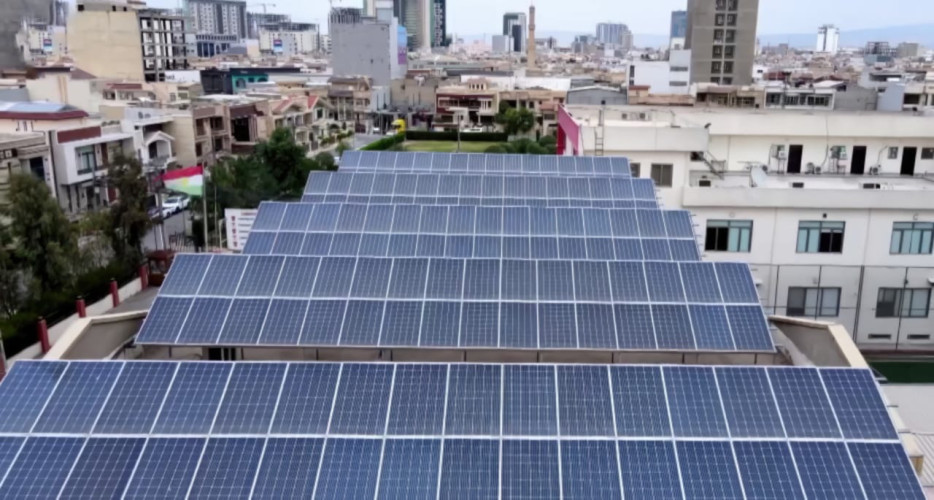
Peregraf
Hardi Osman's household in Sulaimaniyah is different from his neighbors. It has twelve hours of electricity each day, without paying a single penny. He also avoids the noise and pollution of generators and waiting for government electricity to switch back on.
Osman has all of these advantages because he has installed solar panels, a power inverter, and batteries on his roof to capture the energy produced by the Kurdistan Region’s ample sunlight.
"The system produces four to five amperes of electricity, which I use for twelve hours each day: eight hours during the day and four hours at night," Osman told Peregraf. He explained that sometimes he gets more power out of the panels, particularly in the summer when there is more daylight and fewer cloudy days.
He has been using the system for about a year. Although it cost about $3,000 to install, he said that he has benefited from savings elsewhere. A typical system lasts six years, at which time the batteries need to be replaced.
Peshraw Nuri, director general of generation at the Kurdistan Regional Government’s (KRG) Ministry of Electricity, said that using solar power will greatly benefit residents because it is a renewable source of electricity that will reduce their energy costs over time.
Residents in Iraq and the Kurdistan Region frequently experience blackouts and electricity shortages, particularly in high-use periods in summer and winter.
The Kurdistan Region typically generates between 3,200 and 3,500 megawatts, but needs 5,500 to 6,000 megawatts to meet average demand. This can go up to 7,000 megawatts in high-use seasons. According to the KRG Ministry of Electricity, the Region has more than 1.45 million electricity subscribers and this increases by 100,000 subscribers per year.
Over the past few weeks, residents have been getting remarkably low levels of service, with just four and eight hours of government-provided electricity per day.
During blackouts, households and businesses typically turn to private, diesel-powered generators in their neighborhoods. There are about 5,000 such generators in the Kurdistan Region, which are noisy and create high levels of air pollution.
According to statistics from the Sulaimaniyah Electricity Authority, 150 households in Sulaimaniyah have installed solar systems on the roofs. This yields approximately 1.5 megawatts of electricity.
However, the total amount of solar power generated is likely higher. The statistics do not yet count unregistered systems used by factories, businesses, or people in villages.
For example, Hazarmerd village, which is located just south of Sulaimaniyah city and has 26 households, gets at least twelve to fifteen hours of electricity per day from solar systems. The villagers say that they run all their appliances using solar power and have no problems, unlike when they used government-supplied power.
"Because the cost of the system is high initially, if there is cooperation from the government and companies to install the system or provide bank loans, most citizens will start using solar electricity generation," Shadman Shwkry said.
Several solar companies have been established to sell and install solar power systems in the Kurdistan Region, but the quality of their services and products varies widely.
Kamal Abdullah, director of a solar power company, told Peregraf that "the Kurdistan Region will not need private generators and the problem of electricity shortage will be solved" if the government invests more in solar energy, which is abundantly available given the climate.
One of the major benefits will be to reduce the use of neighborhood generators. The KRG’s Environment Board says that they create environmental damage and are a public health hazard because of the pollution that they produce.
Omid Ahmad, spokesman for the KRG Ministry of Electricity, told Peregraf that the government has already announced plans to build three solar power plants located in Sulaimaniyah, Erbil, and Duhok governorates. They would each produce 25 megawatts.
"The foundation stone for the Erbil plant was laid [in May] and there is more work to be done," Ahmad said. The $100 million project is located in Minara village and is expected to be completed next year.
"Nothing has been done for the Sulaimaniyah and Duhok plants yet," Ahmad said.
There are already two existing solar power facilities in the Kurdistan Region, which produces 3 megawatts.
The KRG’s electricity ministry has said that residents who use solar power will receive rebates if they connect their systems to the public grid.
Currently, the vast majority of electricity in the Kurdistan Region is produced by power plants that burn natural gas. There are also two large hydroelectric dams, which are located at Dukan and Darbandikhan.
As the world gathers at COP28 in the United Arab Emirates this week, it is clear that renewable sources of energy are the future. It reduces emissions of carbon dioxide and other greenhouse gasses that contribute to climate change.
Nuri told Peregraf that increasing the Kurdistan Region’s use of solar power is one of the ways to improve management of the energy sector and reduce costs.
"It is a clean and environmentally friendly source," he said. This compares favorably to other energy sources like kerosene, diesel, or natural gas, which are expensive and harmful to the environment.